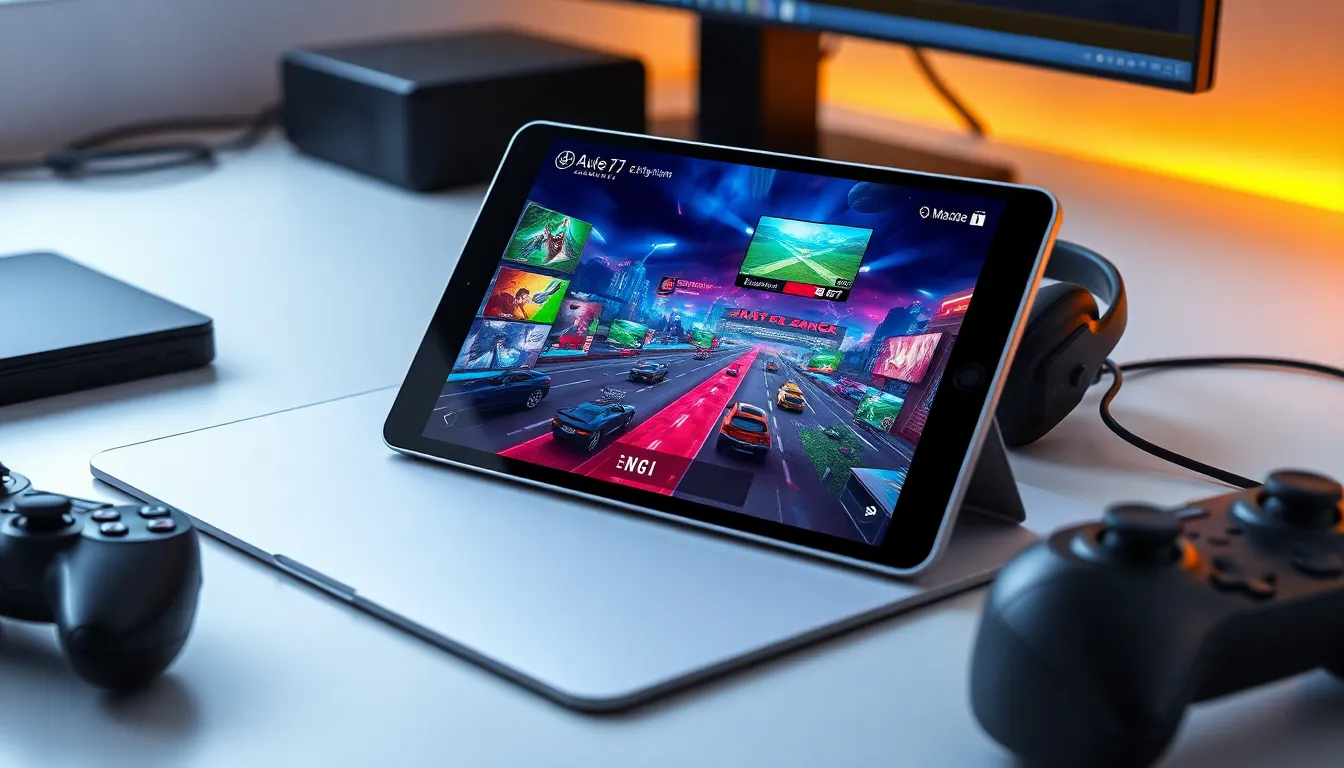In the fast-paced world of tablets, refresh rate is the unsung hero that can make or break your digital experience. Picture this: you’re scrolling through your favorite social media feed, and everything feels smooth as butter. That’s the magic of a high refresh rate working behind the scenes. But when it lags like a tortoise on a lazy Sunday, you might just want to toss it out the window.
Table of Contents
ToggleUnderstanding Tablet Refresh Rate
Tablet refresh rate defines how often the display updates images per second. Measured in hertz (Hz), a higher refresh rate results in smoother visuals. An 60 Hz refresh rate means the screen refreshes 60 times per second, while 120 Hz refreshes twice as often. Many users notice the difference when scrolling through apps or gaming.
User experiences vary based on refresh rate. For instance, scrolling through social media feels fluid on a tablet with a 120 Hz refresh rate. In contrast, a 60 Hz display can appear choppy, making content less enjoyable. Gamers particularly benefit from high refresh rates, as rapid movements in video games appear more seamless.
Several manufacturers design tablets featuring varying refresh rates. The iPad Pro, for example, offers a 120 Hz ProMotion display, enhancing performance significantly. Competitors like Samsung provide models with similar capabilities, boosting the appeal for multimedia tasks.
Adjusting the refresh rate may also impact battery life. Reducing the refresh rate can extend battery life, but may compromise user experience during high-intensity tasks. Many tablets allow users to toggle settings, balancing performance with efficiency.
Understanding refresh rate helps buyers make informed choices. Choosing a tablet with an optimal refresh rate aligns with user needs and preferences. Enhanced visuals improve interactions with content, ultimately shaping a user’s satisfaction with their device.
Importance of Refresh Rate


Refresh rate plays a crucial role in delivering an optimal tablet experience. It significantly influences how users interact with their devices, shaping everything from scrolling to gaming.
Impact on User Experience
Higher refresh rates lead to smoother navigation, enhancing user satisfaction. Tablets with refresh rates of 120 Hz make transitions between apps and scrolling through content seamless. Users often notice a marked difference when switching from a 60 Hz to a 120 Hz device. That smoothness reduces frustration and makes digital interactions more enjoyable. Engaging with multimedia content, such as videos or graphics, benefits from higher refresh rates as well. Overall, users find enhanced responsiveness and enjoyment when using devices with improved refresh capabilities.
Gaming Performance Considerations
Gaming on tablets often demands high-performance visuals. A refresh rate of 120 Hz can make gameplay feel fluid and immersive. Players notice smoother animations and quicker responses during action sequences. Those using tablets for competitive gaming benefit from reduced motion blur and enhanced clarity. On the other hand, a lower refresh rate can lead to lag and a less enjoyable experience. Graphics-intensive games, in particular, require the advantages provided by higher refresh rates. Ultimately, tablets that support higher refresh rates deliver better performance for gaming enthusiasts.
Comparing Refresh Rates
Understanding the differences in refresh rates is crucial for a better user experience. Variations in refresh rates can significantly affect how content appears on devices.
60Hz vs 120Hz
60 Hz refresh rates often serve as the standard across many tablets and typically offer a decent viewing experience. Users may notice some lag when scrolling or transitioning between apps on these devices. In contrast, 120 Hz refresh rates enable smoother interactions. Actions feel seamless, particularly noticeable during gaming or fast-paced content consumption. Motion appears more fluid, enhancing overall user satisfaction when switching between activities. Many users prefer the high refresh rate for its ability to elevate multimedia performance. Gamers particularly benefit from this upgraded experience, as higher rates reduce motion blur.
High Refresh Rate Tablets
Numerous tablets now feature high refresh rates, leading the market in user satisfaction. Apple’s iPad Pro, for example, provides a 120 Hz display that enhances fluidity while scrolling and gaming. Samsung offers similar options, attracting users seeking immersive experiences. As more manufacturers adopt high refresh rates, choices for consumers expand. These tablets enhance overall navigation, reducing fatigue during extended use. The increased cost of high refresh rate models often reflects their superior performance. Users find that investing in a high refresh rate tablet pays off, especially for gaming and multimedia applications.
Tips for Choosing the Right Tablet Refresh Rate
Selecting the optimal refresh rate for a tablet significantly impacts user experience. Consider personal usage habits; if gaming is a priority, a 120 Hz refresh rate enhances fluidity and reduces motion blur. Assess multimedia consumption; higher refresh rates improve the enjoyment of videos and scrolling through content.
Evaluate battery life alongside refresh rates. While high rates deliver smooth performance, they can lead to quicker battery drain. A balance between refresh rate and battery efficiency often suits everyday tasks better. Check manufacturer specifications. Some brands, like Apple and Samsung, prominently feature high refresh rates, appealing to power users.
Review how different refresh rates affect app performance. Transitioning between applications benefits greatly from 120 Hz displays, while lower rates may cause lag. Explore user reviews to understand real-world applications of refresh rates. User feedback provides insights into performance during intensive tasks like gaming, which can guide decisions.
Test devices in-store if possible. Direct experience reveals how refresh rates influence smoothness, offering firsthand knowledge about casual use and gaming. Prioritize future-proofing by choosing a tablet with a higher refresh rate; this investment enhances usability as software and media continue to evolve.
Check for adjustable refresh rates on tablets, enabling variations for specific tasks. Some models allow toggling between settings to conserve battery during less demanding applications. With the proliferation of high-refresh-rate tablets, making an informed choice ensures a satisfying user experience across a range of activities.
Choosing the right tablet refresh rate is crucial for enhancing user experience. Higher refresh rates provide smoother interactions making tasks like scrolling and gaming more enjoyable. While it’s important to consider battery life trade-offs, opting for a tablet with a higher refresh rate can significantly improve multimedia consumption and gaming performance.
As the market continues to evolve with more tablets offering advanced refresh rates, users should prioritize their specific needs and habits. Testing devices and checking manufacturer specifications can help ensure a satisfying experience. Ultimately, investing in a tablet with a higher refresh rate can lead to greater satisfaction and efficiency in daily use.









